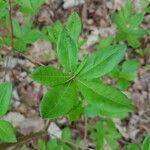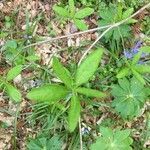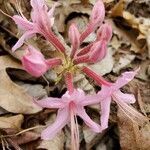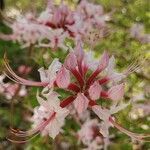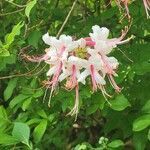Shrubs, to 3(-5) m, usually not rhizomatous. Stems: bark smooth to vertically furrowed, shredding; twigs scattered, multicellular eglandular-hairy (hairs unbranched) or such hairs ± absent, otherwise glabrous or sparsely unicellular-hairy. Leaves deciduous; petiole multicellular eglandular-hairy and unicellular-hairy; blade ovate to obovate, 3-9(-12.5) × 1.4-3.8(-5) cm, thin, membranous, margins entire, plane, ciliate, eglandular-hairy, often strikingly so, apex acute to obtuse, often mucronate, abaxial surface often glabrous or, sometimes, sparsely unicellular-hairy, sometimes sparsely eglandular-hairy, adaxial surface sometimes scattered eglandular-hairy, otherwise glabrous or, sometimes, sparsely unicellular-hairy. Floral bud scales usually glabrous abaxially, margins unicellular-ciliate. Inflorescences 6-15-flowered; bracts similar to bud scales. Pedicels 4-19 mm, eglandular-hairy, otherwise glabrous or sparsely unicellular-hairy. Flowers opening before or with leaves, erect to horizontal, slightly fragrant; calyx lobes 0.5-2.5(-4) mm, surfaces and margins scattered, eglandular-and/or, rarely, stipitate-glandular-hairy, otherwise glabrous or moderately unicellular-hairy; corolla deep pink to white with pink tube, without blotch on upper lobe, funnelform, 23-45 mm, scattered, multicellular eglandular-hairy and/or, less commonly, multicellular stipitate-glandular-hairy (hairs not forming distinct lines), otherwise sparsely to moderately unicellular-hairy on outer surface, petals connate, lobes 9-25 mm, tube usually gradually expanded into lobes, 12-27 mm (equaling or longer than lobes); stamens 5, much exserted, ± unequal, 32-68 mm. Capsules borne on erect pedicels, 10-30 × 3-6.5 mm, eglandular-hairy, otherwise glabrous or sparsely unicellular-hairy. Seeds without distinct tails; testa rather close, but ± loose. 2n = 26.
More
Colonial shrub to 2 m, branched above; winter bud scales glabrous; lvs oblong to narrowly obovate, not fully expanded at anthesis, later 5–10 cm, essentially glabrous except for the marginal cilia and a row of appressed setae along the midrib beneath; fls fragrant to nearly inodorous; pedicels and cor-tube hirsute or rarely glandular; sep mostly under 1 mm, shorter than their cilia; cor pink to white, 4–5 cm, the lobes tending to be arcuate-reflexed and to have loosely revolute margins, so that they look narrow and the limb is open, in contrast to no. 5 [Rhododendron prinophyllum (Small) Millais], with flatter lobes and a fuller limb; ovary densely strigose, fr sparingly so. Moist or dry woods and bogs; Vt. and Mass. to c. N.Y., s. to S.C. and Tenn.; s. Ill. Late Apr., May. (R. nudiflorum, an illegitimate name; Azalea n.)
A shrub. It grows 1-2 m tall. It loses its leaves during the year. The flowers are white or pink.
